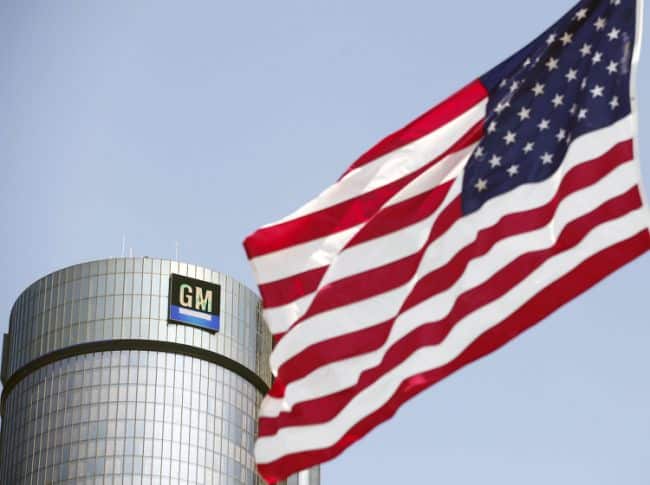(GM headquarters in Detroit.Bill Pugliano/Getty Images)
• Morgan Stanley continues to press for GM to spin off aspects of its business.
• GM has a bad history with spinoffs.
• GM owns its current strategy and doesn’t need to follow Wall Street’s lead.
At some point in the past five years, Wall Street stopped understanding the car business.
Major, publicly traded carmakers such as General Motors and Ford survived the financial crisis (GM had to endure federal bailout and bankruptcy) and have enjoyed a robust recovery in the US auto market and breakneck growth in China.
They raked in profits amid booming pickup truck and SUV sales. But investors have been unimpressed. Captivated by the alleged disruptions from Tesla and Uber and the ongoing mobility experiments of Google’s Waymo, markets have kept auto stocks in underperform territory.
GM shares have been edging up over the past month, reaching levels not seen since the company’s 2010 IPO, but Ford remains in the doghouse, despite repeatedly posting profitable quarters. And generally speaking, Wall Street thinks any optimism about traditional car companies is too late, as the industry girds itself for a sales downturn in the US after record years in 2015 and 2016.
The struggles of Morgan Stanley
(GM’s Steyn speaks about the new Maven services unit during the North American International Auto Show in Detroit.Thomson Reuters)
No bank analyst is trying harder to sort out Wall Street’s relationship to cars than Morgan Stanley’s Adam Jonas. He’s become more bullish on GM, but there’s a catch: he wants the company to break itself up, in an effort to unlock value from the company’s newer ventures into self-driving cars and ride-sharing. His catch-all term for these new undertakings is “Auto 2.0.”
This is from a research note published Tuesday:
At this point in the cycle (both in the US and globally), it is extremely difficult to sustainably push earnings expectations to new highs, particularly given the number of factors that drive incremental auto credit/demand completely outside of an auto firm’s control. Some of the few things within an auto firm’s control include its strategic outlook, company reporting structure and business/capital structure. At this point in the auto cycle, we are not surprised to see auto firms spend greater portions of their presentations focused on a thoughtful pivot to Auto 2.0.
Wall Street has caught this spinoff or restructuring bug largely because of Fiat Chrysler Automobiles, which spun off Ferrari in what is now considered a wildly successful 2015 IPO. The spinoff was led by the financially astute CEO Sergio Marchionne.
In 2017, Ferrari shares have blown away the markets, up a stupendous 93%.
GM should follow suit and spinoff Cadillac or its Maven ride-hailing/sharing brand, goes the thinking.
The carmaker might be entertaining this idea, which would, of course, open up some advisory opportunities for Morgan Stanley (don’t think that Jonas is crossing any lines here, however — his ideas really have been more strategically speculative than anything else).
A bad track record
(Wall Street is captivated by Tesla.Thomson Reuters)
But GM has spun off assets before and been burned (parts maker Delphi, for example, which became one of the longest bankruptcies in US history). Cadillac doesn’t make much sense as a stand-alone Tesla competitor because it lacks sales volumes (but not profits) and Maven is still in the early stages of establishing its brand. Ferrari, by contrast, has a long history and a legendary brand that a lot of people probably thought was on its own, not owned by Fiat and in turn FCA.
What Wall Street is missing about GM is that GM doesn’t care what Wall Street thinks about its strategic future. CEO Mary Barra and her team care about the stock price, but years of watching it lag the markets haven’t kept them from paying out a healthy dividend.
The carmaker has a strategic vision, and it’s executing on it. We’ve seen this with the sale of the long-underperforming Opel division to Peugeot earlier this year, the creation of Maven, the acquisition of Cruise Automation to leap forward on urban autonomous vehicles, a $500-million investment in Lyft, the rapid development and marketing of the Chevy Bolt long-range electric car, and most recently, the announcement that 20 new EVs will arrive by 2023.
This leaves Wall Street in a weird spot. Some investors will have to accept that GM is a well-managed business dedicated to returns on investment, with a solid game plan to remain relevant if nor revolutionary for decades to come. Others will have to twist themselves into knots to figure out if futuristic mobility technologies from new players, many based in Silicon Valley with no prior exposure to the car business, will pan out.
Expect GM, now outpacing its peers and thriving in both the US and China, to be a focal point for Wall Street’s confusion for the next few years.

